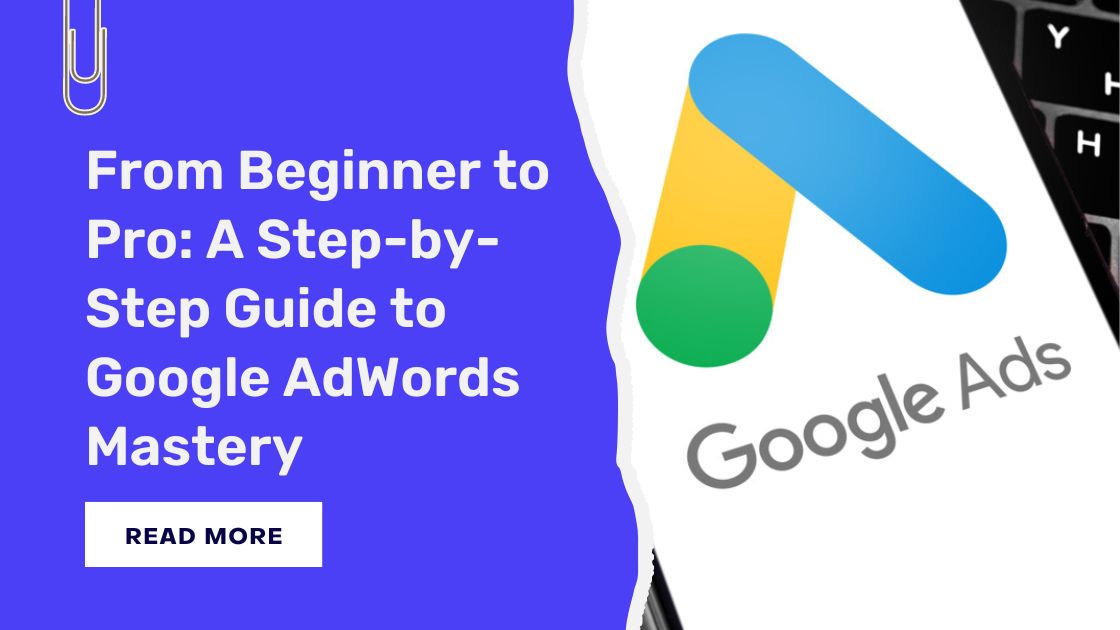Google Ads or Google adwords is a powerful advertising platform that allows businesses to reach potential customers through targeted online ads. With the right strategies and techniques, Google Ads can help businesses increase their online visibility, drive website traffic, and generate leads and sales. In this guide, we’ll cover the key steps to mastering Google Ads, from setting up your account to optimizing your campaigns for maximum performance.

Understanding Google Ads
Google Ads is a pay-per-click (PPC) advertising platform that allows businesses to create and display ads on Google search results pages and other websites in the Google Display Network. Advertisers bid on keywords and phrases relevant to their products or services, and when a user searches for those keywords, the ads appear at the top of the search results page. Google Ads uses a sophisticated algorithm to determine which ads to display based on factors such as relevance, quality score, and bid amount.
Benefits of Mastering Google Ads
Mastering Google Ads can bring numerous benefits to businesses, including:
- Increased visibility: Google Ads can help businesses reach a wider audience and increase their online presence.
- Targeted reach: Google Ads allows businesses to target their ads to specific demographics, locations, and interests, ensuring that their ads are seen by the right people.
- Measurable results: Google Ads provides detailed analytics and reporting, allowing businesses to track their campaign performance and measure their return on investment.
- Cost-effective: Google Ads operates on a bidding system, allowing businesses to set a budget that works for them and only pay when users click on their ads.
Setting Up Your Google Ads Account
Setting up a Google Ads account is a straightforward process that involves the following steps:
- Creating a Google Ads account: Go to the Google Ads website and follow the prompts to create a new account.
- Setting up a campaign: Choose the type of campaign you want to create (search, display, video, etc.) and set your campaign goals, budget, and targeting options.
- Creating ad groups: Within each campaign, create ad groups that contain related keywords and ads.
- Writing ad copy: Create compelling ad copy that includes a clear call-to-action and relevant keywords.
- Setting bids: Determine how much you’re willing to pay for each click on your ads.
Keyword Research and Selection
Keyword research is a critical step in setting up a successful Google Ads campaign. Here are some tips for conducting effective keyword research:
- Identify relevant keywords: Use keyword research tools like Google Keyword Planner or SEMrush to identify keywords and phrases related to your products or services.
- Analyze search volume: Look at the search volume for each keyword to determine which ones are most popular and relevant.
- Consider long-tail keywords: Long-tail keywords are more specific and less competitive, making them a great option for businesses with a limited budget.
- Use negative keywords: Exclude irrelevant keywords to ensure that your ads are only shown to users who are likely to be interested in your products or services.
Ad Copywriting and Design
Creating compelling ad copy and design is essential for attracting clicks and conversions. Here are some tips for creating effective ad copy and design:
- Use a clear and concise headline: Make sure your headline accurately reflects the content of your ad and includes relevant keywords.
- Include a call-to-action: Encourage users to take action by including a clear call-to-action in your ad copy.
- Use ad extensions: Ad extensions allow you to add additional information to your ads, such as phone numbers, addresses, and links to specific pages on your website.
- Use high-quality images: If you’re creating display or video ads, make sure to use high-quality images that accurately represent your products or services.
A/B Testing and Performance Analysis
A/B testing is a powerful technique for optimizing your Google Ads campaigns. Here’s how to conduct effective A/B testing:
- Create two versions of your ad: Create two versions of your ad with slight variations, such as different headlines or calls-to-action.
- Split your audience: Split your audience into two groups and show each group a different version of your ad.
- Analyze performance: Analyze the performance of each ad to determine which one is more effective.
- Make adjustments: Based on your analysis, make adjustments to your ad copy, design, or targeting options.
Conversion Tracking and ROI Measurement
Conversion tracking is essential for measuring the success of your Google Ads campaigns. Here’s how to set up conversion tracking and measure your return on investment:
- Set up conversion tracking: Use Google Analytics or Google Ads conversion tracking to track the actions that matter most to your business, such as purchases, sign-ups, or downloads.
- Analyze conversion data: Analyze your conversion data to determine which campaigns, ad groups, and keywords are driving the most conversions.
- Calculate ROI: Calculate your return on investment by dividing the revenue generated by your Google Ads campaigns by the cost of those campaigns.
By mastering these key steps, businesses can unlock the full potential of Google Ads and drive measurable results for their marketing efforts.
Conclusion
In conclusion, mastering Google Ads is a critical skill for businesses looking to increase their online visibility, drive website traffic, and generate leads and sales. By understanding the basics of Google Ads, setting up a campaign, conducting keyword research, writing compelling ad copy, optimizing your campaigns through A/B testing and performance analysis, and tracking conversions and measuring ROI, you can create effective and successful Google Ads campaigns.
If you’re looking to enhance your digital marketing skills, consider taking a best digital marketing course in Laxmi Nagar. A comprehensive course can help you learn the latest trends and best practices in digital marketing, including Google Ads, and provide you with the technical expertise and creative skills needed to create successful marketing campaigns.
Remember, Google Ads is a constantly evolving platform, so it’s important to stay up-to-date with the latest trends and best practices. Continuously testing and optimizing your campaigns can help you stay ahead of the competition and ensure that you’re getting the most out of your advertising budget.
Additionally, it’s important to keep in mind that Google Ads is just one piece of a larger digital marketing strategy. Integrating Google Ads with other marketing channels, such as email marketing, social media, and search engine optimization, can help you create a cohesive and effective marketing strategy that drives results for your business.
In summary, mastering Google Ads requires a combination of technical expertise, creativity, and continuous learning. By following the steps outlined in this guide, you’ll be well on your way to creating successful Google Ads campaigns that drive measurable results for your business










